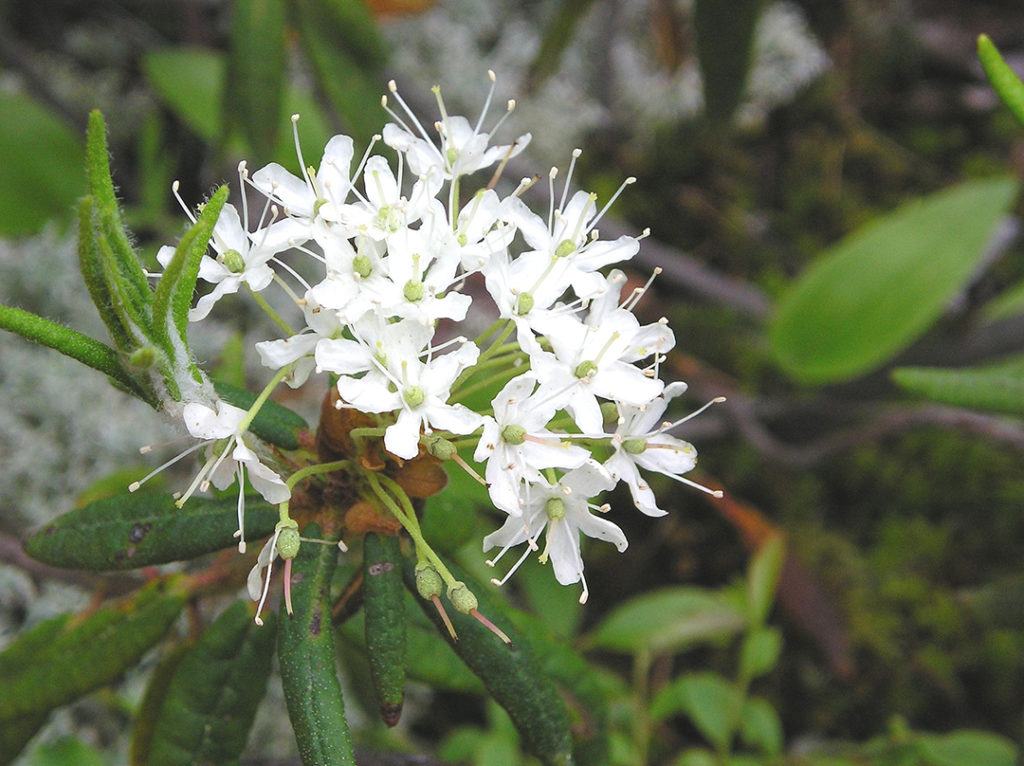
Greenland
Qajaassat
Ledum groenlandicum

General Description / Cultural Significance
Qajaassat, Ledum Groenlandicum, is a plant from Greenland with a distinctive scent. The Greenlandic name itself means “the ones that look like kayaks” because of its leaf shape. Qajaassat is a low evergreen shrub with aromatic, furry elliptic leaves and copper-colored bark. It is used as a tea and spice. The tea provides a host of benefits, used to cure headaches, coughs, sore throats, and lung infections. It is thought to thin mucus. In the past, it has been used by women to cause abortions and leaves were rubbed on wounds or sores to help heal them. Science suggests qajaassat is antimicrobial, antiviral, and antifungal, in addition to having insecticidal properties. It is thought to be mildly toxic in large doses, in the way that caffeine can be.
Climate Change/Conservation Status
Eighty-four percent of Greenland’s land mass is covered by the Greenland ice sheet. it is one of the largest and most quickly melting chunks of ice on Earth and its melting could increase sea levels by about 20 feet. The story of climate change in Greenland is best told in the fact that over the last two decades the country has lost over 300 billion tons of ice each year.
The culture of Greenland is deeply rooted in hunting on which there is increased control, with additional pressure coming from climate change. Climate change is affecting both mammals and fish. With a melting Arctic and rising seawaters, hunters are spending more time in the fjords rather than on sea ice. Age-old fishing techniques can no longer be used in some instances due to new problems with worms and parasites that have moved north with the warmer water. Dramatic changes in the homeland of the Inuit are transforming more than the environment—they’re transforming their way of life. The loss is felt not just under their feet as the sea ice thins and melts, but in their hearts, with a loss that many cannot fully comprehend. As the Inuit people try to map out the future of themselves and the arctic, many cannot see one due to the catastrophic change. This, more than anything else, may be responsible for the high suicide rate.
A study published in January 2019 shows that Iceland’s ice sheet is melting at an accelerated rate and may soon be at a “tipping point”. This fact makes it a major factor in sea level rise around the world. Because the arctic has been found to be warming at twice the average rate as the rest of the planet, it is now known that estimates for sea level rise have been too conservative. Antarctica lost roughly 250 billion tons each year for the past decade.
The highest above average temperatures were recorded across Greenland in 2019. The heat wave that hit Europe in June, setting record temperatures, came Greenland’s way, creating summer temperatures ten degrees higher than average and increasing the surface melt of the ice sheet that covers eighty percent of the island. The National Snow and Ice Data Center in Boulder, Colorado, analyzed satellite data, confirming that 380,000 square miles, sixty percent of the ice sheet, had accelerated melting.
As of 2021, surface melt was actually below average, as were temperatures according to the National Snow & Ice Data Center (NSIDC) a division of NASA. Though there was a slight change in the positive direction, the effects of climate change are unpredictable and still present grave risks.
Alternate Names
Bay tea
Bog Labrador tea
Hudson’s bay tea
Labrador tea
Marsh tea
Rusty Labrador tea
Swamp tea
Sources
Fountain, H., 2021. It Rained at the Summit of Greenland. That’s Never Happened Before. The New York Times. [website]

